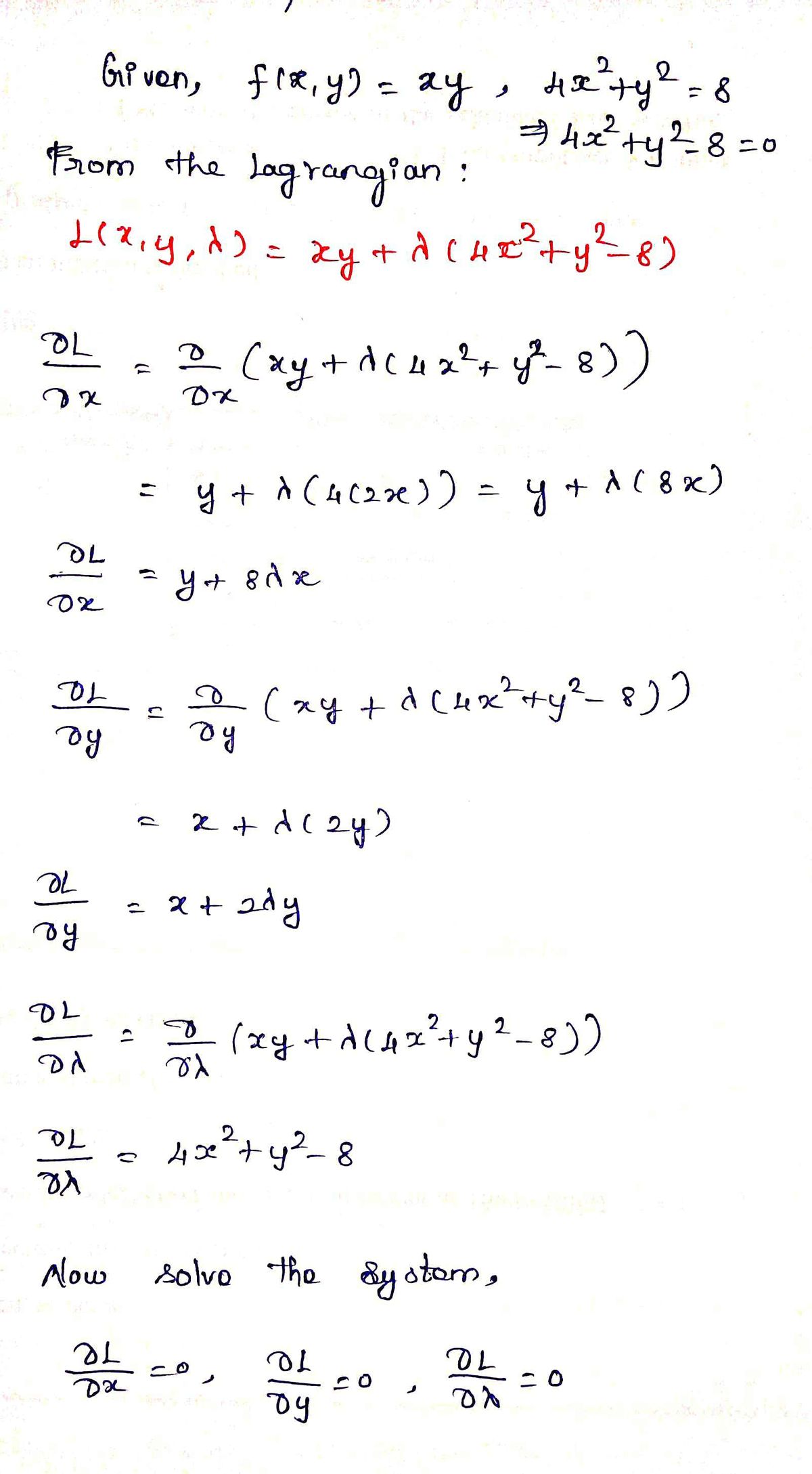nis extrenme value pbem has a Solutiun with both a maximum value and minimum Valve.Use langcange Multiplicrs to Aind the oxtrere Values of the functiun. Subject to tre gmen Cunstramt maximum Valve minimum Valve
nis extrenme value pbem has a Solutiun with both a maximum value and minimum Valve.Use langcange Multiplicrs to Aind the oxtrere Values of the functiun. Subject to tre gmen Cunstramt maximum Valve minimum Valve
Calculus: Early Transcendentals
8th Edition
ISBN:9781285741550
Author:James Stewart
Publisher:James Stewart
Chapter1: Functions And Models
Section: Chapter Questions
Problem 1RCC: (a) What is a function? What are its domain and range? (b) What is the graph of a function? (c) How...
Related questions
Question
![**Extreme Value Problem with Lagrange Multipliers**
This extreme value problem has a solution with both a maximum value and minimum value. Use Lagrange multipliers to find the extreme values of the function, subject to the given constraint.
\[ f(x, y) = xy \]
Subject to:
\[ 4x^2 + y^2 = 8 \]
**Box for Solutions:**
- Maximum Value: [Box]
- Minimum Value: [Box]
---
**Explanation:**
In this problem, you are tasked with finding the extreme (maximum and minimum) values of the function \( f(x, y) = xy \) subject to the constraint \( 4x^2 + y^2 = 8 \). This is typically solved using the method of Lagrange multipliers, which involves setting up and solving equations to find where the gradients of the function and the constraint are parallel. The values found will represent the local extremes of the function within the given constraints, which are filled into the boxes provided.](/v2/_next/image?url=https%3A%2F%2Fcontent.bartleby.com%2Fqna-images%2Fquestion%2Fe040b111-4b10-4c24-8337-c45ed461242d%2F62fffc63-5423-4596-b29a-fb907c0a7006%2Fngg8tcn_processed.jpeg&w=3840&q=75)
Transcribed Image Text:**Extreme Value Problem with Lagrange Multipliers**
This extreme value problem has a solution with both a maximum value and minimum value. Use Lagrange multipliers to find the extreme values of the function, subject to the given constraint.
\[ f(x, y) = xy \]
Subject to:
\[ 4x^2 + y^2 = 8 \]
**Box for Solutions:**
- Maximum Value: [Box]
- Minimum Value: [Box]
---
**Explanation:**
In this problem, you are tasked with finding the extreme (maximum and minimum) values of the function \( f(x, y) = xy \) subject to the constraint \( 4x^2 + y^2 = 8 \). This is typically solved using the method of Lagrange multipliers, which involves setting up and solving equations to find where the gradients of the function and the constraint are parallel. The values found will represent the local extremes of the function within the given constraints, which are filled into the boxes provided.
Expert Solution
Step 1

Step by step
Solved in 2 steps with 2 images

Recommended textbooks for you

Calculus: Early Transcendentals
Calculus
ISBN:
9781285741550
Author:
James Stewart
Publisher:
Cengage Learning

Thomas' Calculus (14th Edition)
Calculus
ISBN:
9780134438986
Author:
Joel R. Hass, Christopher E. Heil, Maurice D. Weir
Publisher:
PEARSON

Calculus: Early Transcendentals (3rd Edition)
Calculus
ISBN:
9780134763644
Author:
William L. Briggs, Lyle Cochran, Bernard Gillett, Eric Schulz
Publisher:
PEARSON

Calculus: Early Transcendentals
Calculus
ISBN:
9781285741550
Author:
James Stewart
Publisher:
Cengage Learning

Thomas' Calculus (14th Edition)
Calculus
ISBN:
9780134438986
Author:
Joel R. Hass, Christopher E. Heil, Maurice D. Weir
Publisher:
PEARSON

Calculus: Early Transcendentals (3rd Edition)
Calculus
ISBN:
9780134763644
Author:
William L. Briggs, Lyle Cochran, Bernard Gillett, Eric Schulz
Publisher:
PEARSON

Calculus: Early Transcendentals
Calculus
ISBN:
9781319050740
Author:
Jon Rogawski, Colin Adams, Robert Franzosa
Publisher:
W. H. Freeman


Calculus: Early Transcendental Functions
Calculus
ISBN:
9781337552516
Author:
Ron Larson, Bruce H. Edwards
Publisher:
Cengage Learning